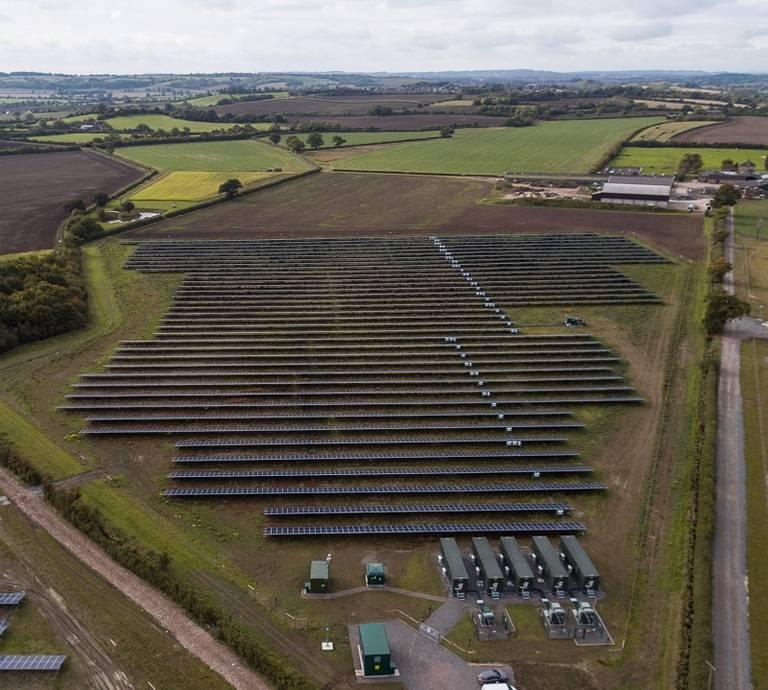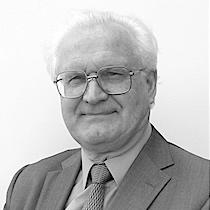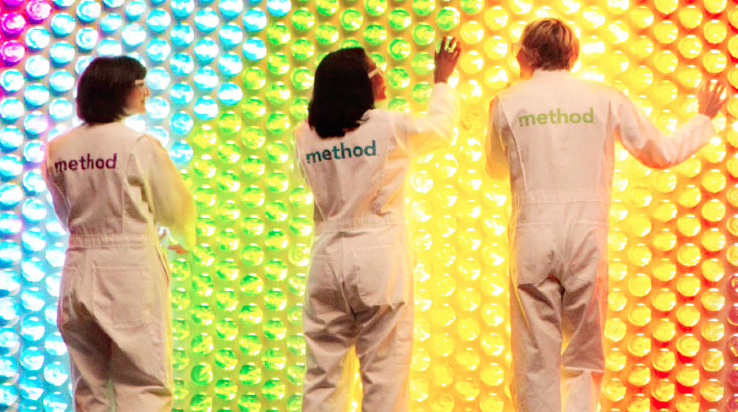Cost Parity Finds More Corporations Investing in Renewables


Now that the cost of renewable energy is reaching a competitive level with fossil fuels, the potential for a bottom line benefit is clearly evident. However, raw dollars and cents only tell part of the story. A new survey describes how corporations can realize more value from renewable energy than meets the eye.
Regardless of the reason, leading corporations have been charging ahead on renewables. The insights contributed by the new survey could help the transition to renewables accelerate, despite President Trump's decision to pull the U.S. out of the Paris Agreement on climate change.
More renewable energy, more value
The new survey was conducted last month by the clean energy developer Apex Clean Energy, through a partnership with GreenBiz Group.
The main takeaway is that corporations transitioning to renewables are also adopting a more holistic approach to business. The majority (65 percent) of survey respondents cite the primary importance of cost in their renewable energy purchases, but other factors also feature strongly.
Corporate goal-setting is a strong driver of renewable energy purchases, cited by 70 percent of respondents. That finding is backed up by the premium that most respondents (65 percent) place on establishing their brand as a renewable energy leader.
Some respondents cite additional motivations:
While 65 percent of respondents cited price as a factor considered when purchasing renewable energy, more than a quarter of respondents also chose value, energy intensity of facilities, length of contract, and credit toward goals.
Considering that Apex is one of the top clean power developers in the U.S., it's no surprise that 23 percent of respondents cited the "reputation of the renewable energy developer" as a factor in their clean power purchases. Nevertheless, that finding goes beyond self-interest. The consulting firm Smart Energy Decisions recently surveyed leading corporate renewable energy buyers as well as those considering their first purchase. They concluded that the reservoir of know-how built up by early adopters is enabling new purchasers to engage with more experienced developers and "leapfrog" into more ambitious, more sophisticated renewable energy investments.
The survey, included 150 respondents with annual revenues topping $250 million or more, and is available online under the title,"2017 State of Corporate Renewable Energy Procurement Survey."
Renewable energy and microgrids
As for the raw bottom line, the new survey also teases out some important advantages of renewable energy:
Corporate buyers increasingly seek renewables as cost-competitive sources of new power generation that offer a hedge against price volatility from traditional energy sources. More opportunities to buy and finance clean energy exist than ever before, allowing buyers to purchase on their terms and harness internal expertise they already possess.
Apex focuses its business on utility scale projects, but the survey also hints at the emerging, consumer-oriented energy scenario leveraging microgrids, distributed energy resources and renewables.
Interest in the localized, microgrid solution is ramping up as corporations begin to realize the benefits in terms of consumer options and flexibility.
The energy consumer aspect is underscored by a dozen in-depth interviews that Apex and GreenBiz included in the survey:
The in-depth interviews of market leaders highlighted a clear trend toward moving beyond purchasing renewable energy credits (RECs) as a strategy due to the lack of additionality. This was driven by skepticism that REC purchases alone were driving new renewable energy capacity and creating real-world greenhouse gas reductions.
That "lack of additionality" also resonates in terms of energy security. Hurricanes Harvey, Irma and Maria have exposed vulnerabilities in the conventional grid model, as has the threat of cyber-attacks.
Paris, or no Paris...
All in all, the new survey reaffirms the general state of affairs: Leading U.S. corporations are determined to act on climate change:
Despite the federal action to withdraw from the Paris climate accord, 84 percent of all respondents plan to actively pursue or consider directly buying clean energy, and 43 percent plan to become more aggressive in the next 24 months.
Those numbers are all the more impressive considering the lack of direction from President Trump.
In the latest development, earlier this month word leaked that Trump would reconsider his previous Paris Agreement withdrawal. That rumor was quickly quashed by the White House, in such a way that indicated the President does not actually understand -- or pretends not to understand -- the terms of the agreement.
Steve Cohen, executive director of the Earth Institute at Columbia University, explained the problem in a recent op-ed:
...Trump’s Press Secretary Sarah Sanders tweeted on Sept. 16: “Our position on the Paris agreement has not changed. @POTUS has been clear, U.S. withdrawing unless we get pro-America terms.”It’s not clear what is anti-American about the climate agreement. The agreement asks each sovereign nation to set its own greenhouse gas reduction targets and report on those targets every five years...
Considering Trump's track record as a businessman and U.S. President, that kind of deep misunderstanding will not be cleared up any time soon.
Fortunately, U.S. business leaders are taking up the slack, and helping to steer the nation toward a more safe and sustainable model.
Image (cropped): via Apex Clean Energy.
UK Switches on First Subsidy-Free Solar Farm with Battery Storage


This week, the United Kingdom launched a new solar plant outside the town of Flitwick, about an hour's drive north of London. But unlike some of the UK's largest solar installations, the Clayhill Solar Farm was planned and built without any government subsidies or incentive such as feed-in tariffs.
Furthermore, a 6MW battery battery storage unit will complement the 10MW solar plant in the county of Bedfordshire. The installation marks another step forward in the UK's clean energy future as the current government has made it clear it wants such projects to continue without any subsidies.
The Chinese battery manufacturer BYD will supply the battery units as well as the solar panels. Huawei will provide 1,500-volt inverters that the company claims are a "breakthrough" for the global solar sector. About 31,000 solar panels in total are spread across 45 acres.
The United Nation's climate action program has hailed Clayhill as "tipping point for the industry," due to the fact it is financed entirely by private investors.
Not so fast, say some observers. The Financial Times noted that Clayhill was built next to a large solar plant already in operation, allowing for the new installation to benefit from grid connections and other equipment already in place. So even though renewables continue to plummet in price worldwide, the costs involved with linking them to the grid suggest some financial incentives will still be necessary in the near future. "In a nutshell: find a site where you can lean on existing infrastructure," summed up MIT Technology Review.
Nevertheless, Clayhill proves that renewables still have a potent future. Steve Shine, CEO of Anesco, the clean energy developer leading the project, told PV Magazine that the budgeting of the project required a close examination of everything during the planning and construction phases. The overall design, technical specifications and the entire supply chain underwent a rigorous assessment as subsides of any kind were out of the picture. "By deciding to co-locate the 6 MW battery storage unit and by working closely with our supply chain partners, we have been able to achieve a subsidy-free development," he explained to reporter Ian Clover in an interview.
The addition of Clayhill to the UK's energy portfolio comes on the heels of the country's national utility's description of summer 2017, a conclusion that it was the "greenest ever." National Grid estimated that between late June and last week, the carbon intensity of the UK's grid (as in grams of carbon emitted for each kilowatt-hour of power generated), was reduced to half its level four years ago. Low carbon sources contributed 52 percent of the carbon's generation, compared to 35 percent in 2013. Projects such as Clayhill, in addition to cheaper offshore wind power, will boost renewables' share of the UK's power generation even more in the coming years.
Image credit: Anesco
Three aspirations for long distance EVs


SC Johnson's Buy of Method and Ecover Latest in Becoming Sustainable by Acquisition


Earlier this month, SC Johnson announced its acquisition of Ecover and Method, two brands that proved sustainable cleaning products could be hip, competitively-priced and effective. The news was generally greeted with a yawn if not overlooked, though that certainly was no fault of Wisconsin-based SC Johnson. Geopolitics and a barrage of headlines have sucked all of the oxygen out of the newswires in recent weeks.
Nevertheless, the cleaning products and consumer packaged goods (CPG) sectors have been in the midst of a longstanding trend, as summed up by SC Johnson's CEO, Fisk Johnson.
“Method and Ecover have a strong tradition of innovation and delivering on consumers’ needs. They are a great complement to SC Johnson’s trusted lineup of iconic brands,” said Johnson in a public statement.
In other words, consumers are increasingly concerned about the sustainability of their products and the conduct of the companies from which they buy their favorite brands.
The outcome is a huge challenge for some of the world's largest CPG companies, who find themselves boxed by changing consumer preferences. Younger consumers want more products with a conscience; other customers, however, are loyal to their favorite brands and would rather not see them change. That tension is in part what drove Unilever to acquire Seventh Generation last year, and the Anglo-Dutch conglomerate was briefly rumored to be in talks to by The Honest Company.
As a result, some analysts said Procter & Gamble was under pressure to complete a similar deal. To date, such an acquisition has not yet occurred; P&G has instead decided to follow a strategy of making "eco-friendly" versions of iconic brands such as Tide Detergent. Meanwhile the company has endured several years of sluggish sales; many of the company's observers are not thrilled with P&G's long term prospects. The problem P&G faces is that if given the choice between a conventional and "eco" product, brand loyalists will stick to what they know. Millennials and more "conscious consumers," meanwhile, will gravitate towards the brightly-colored spray bottles of Method instead of the dowdy alternatives the likes of P&G, Clorox and Unilever have long pitched.
One argument in support of a conventional company buying a smaller "sustainable" firm is the synergy that can result. As profiled on the Guardian in 2013, despite fears that Burt's Bees was "selling out" to Clorox, that was far from the truth. Century-old Clorox became more of a sustainable and lean operation due in part to what it learned from Burt's Bees; the latter in turn could score pointers from Clorox's managerial expertise and the company's distribution channels.
Of course, Oakland-based Clorox had a corporate culture that was open to change. Could the same be said for SC Johnson? The company used to be quite active on the social media front, at one time being a leading voice for corporate sustainability. But that chatter has largely quieted down in the past few years. SC Johnson has certainly tried, from its point of view - for example, the company tinkered with pushing its concentrates to reduce waste (and sent the author a supply to test out), but that push has largely fallen by the wayside.
Could Method's founders, Adam Lowry and Eric Ryan, offer SC Johnson the jolt of "innovation" for which the company inferred it was looking? And will the "family of companies" that comprises SC Johnson be receptive to the "weird" culture Lowry and Ryan instilled at Method's headquarters? If the two cultures can mesh, SC Johnson has a huge opportunity to win new customers over, and not just those buying ylang ylang-scented shower spray.
Image credit: Method
MGM Resorts International Practices Water Conservation in Las Vegas


Water is precious in Las Vegas. Located within the Mojave Desert, it’s a city whose outskirts contain desert vegetation and dry mountain ranges. It gets only 4.17 inches of rain a year, with an average 21 days of rainfall.
Las Vegas is also a major travel destination, with over 42 million visitors in 2016. Resorts actually use only seven percent of southern Nevada’s water, while residents use 59 percent. And 99 percent of the water used inside Las Vegas resort buildings is replenished back into either Lake Mead or the Colorado River.
One resort chain’s practices serve as a good example of water conservation in Las Vegas: MGM Resorts International, which describes itself as a “Las Vegas anchored operation.” The company, which has properties all over the world, including Las Vegas, proves that water can be used sustainably in the driest of climates. It’s water conservation efforts have saved about 1.2 billion gallons of water.
Several of MGM’s properties are featured in its latest CSR report, including the Park, its most recent addition to the Las Vegas Strip. Completed in 2016, most of the resort’s water is supplied by an existing well. A closed-loop system is used to capture, filter and reuse the water flowing in the Park’s water sculptures. Drought tolerant plant species are planted as landscaping, including Agave, Yucca, Palo Verde, Acacia and Mesquites. Water flow is limited to those outdoor plants with the use of point-source drip irrigation and anemometers. These water conservation technologies result in 70 percent less water use. The water irrigation system alone results in 72 percent less water being used overall. The Park has earned LEED Gold Certification from the U.S. Green Building Council.
The T-Mobile Arena also opened in 2016. It will host the NHL expansion team, the Vegas Golden Knights. A 650,000 square foot, 20,000 seat LEED Gold certified venue for sports and entertainment, the Arena is designed with several water efficient technologies such as waterless urinals and low flow toilets that reduce indoor water by 40 percent. The exterior of the Arena features drought tolerant plants and drip irrigation systems, which reduce water use by 80 percent. An on-site well reduces the amount of water taken from the city’s water supply. And the Arena also features high-efficiency LED lighting to decrease energy use.
MGM decided to make its Las Vegas property the MGM Grand, the largest single hotel in the country, more water efficient. In 2016, the company removed 42,000 square feet of grass and replaced it with drought-tolerant plants and artificial turf. Two years prior, the resort increased its use of on-site well water to reduce dependence on water sourced from Lake Mead. All of its exterior irrigation and 60 percent of its cooling tower water needs are provided by well water. The MGM Grand’s water use from Lake Mead decreased by 21 million gallons.
Las Vegas and sustainability are two words that usually do not go hand-in-hand, but MGM proves that they are compatible. And in an arid place, water conservation is simply a must. Just ask MGM.
Photo: MGM Resorts
Sources
https://www.usclimatedata.com/climate/las-vegas/nevada/united-states/usnv0049
http://www.lvcva.com/includes/content/images/media/docs/ES-YTD-2016.pdf
https://www.mgmresorts.com/en/company.html
https://www.mgmresorts.com/en/company/csr/environmental-sustainability/conservation.html
Hurricane Irma Prompts Questions About the Real Benefits of Solar 'Net Metering'


Last July the small burg of South Miami crossed a milestone: It became the first city in Florida to require solar panels to be part of all new homes. Its role in the Sunshine State of America wasn't going to be missed: it was time, city commissioners reasoned, for East Coast residents to join West Coast communities and ensure that renewable energy was part of the city's future.
The new bylaw was just one of several recent efforts in Florida to endorse solar and wind power generation. A month earlier, the Florida state legislature had voted to exempt renewable energy infrastructure from state property taxes and assessments of businesses. It had passed a bill exempting solar and wind from homeowners' state tax assessments more than a decade earlier. The latest changes were hailed as an indicator that Floridians would not only reap the rewards of lower power bills but have greater independence by generating their own power.
That is, except when there is an emergency like a hurricane.
The first thing South Florida residents learned after Hurricane Irma had cleared a swath through their neighborhoods is that investing in renewable energy won't necessarily get your power back on any faster. That is, if you are hooked to the grid and haven't installed batteries. Within hours of making landfall, Irma had knocked out power to millions of people across the state. Homeowners who had solar panels attached to the electricity grid were told they were required to shut them off until Florida Power & Light had restored power in their area. According to the company, the requirement protects workers while repairing downed lines.
Those residents that had back-up battery systems and could access power "off-grid" from stored battery power weren't affected by the restriction. But for the majority of solar owners in sunny Florida, accessing a hot shower, coffee or a hot meal meant waiting until FPL had their neighborhood back on the grid -- same as those neighbors who hadn't spent the money to buy solar panels.
And wait they did. By Sept. 19, almost two weeks after the hurricane barreled up the west coast of the state, more than 3,000 people were still without power, prompting calls for a state review of Florida's power grid, which largely is above ground and was affected by fallen trees. It's also prompted a class-action suit against FPL with questions about why the company has charged "millions and millions [of dollars]" to mitigate for hurricane outages in the past decade, yet allegedly had not completed the work for which they had collected the fees.
For homeowners who invested in solar panels however, FPL has prompted hard questions about the value of hooking their renewable power systems to a grid operated by a state-wide utility company. Within days of the power outage, major media outlets were incorrectly reporting that the real problem stemmed from FPL's own rules that solar users power-down their solar panels and that FPL's regulations were ultimately responsible for lost solar power.
In fact, loss of solar power during a power outage is inevitable for users that don't back up their systems with a battery system, first, which was the case for millions of residents who assumed that being hooked into a net metering system wouldn't affect their "free" access to the sun's electric power.
And, as snopes points out, FPL isn't the only company that publishes a codicil when it comes to the use of solar power during power outages.
"This is a safety precaution and industry-wide standard put in place to prevent line workers from being electrocuted while restoring power during an outage — and it is not unique to Florida," the writers point out.
For solar users then, the real question may be the value they derive from plugging into a regional grid. Are the doing so to save money through net metering, or are they preparing for unforeseen emergencies, like climate-related power outages? And have they investigated the difference?
Florida's recent loses from Hurricane Irma offer a compelling reason for putting regional power lines underground, argues Roger N Anderson. Senior Scholar at the Center for Computational Learning Systems in the Fu School of Engineering and Applied Sciences at Columbia University.
"Given that reality, and the fact that climate change promises more and more violent weather disruptions, we should immediately move to put all power distribution systems underground," suggest Anderson.
But it also may encourage users to become more knowledgeable of just what that new solar energy package will ultimately provide when a storm is at their doorstep.
Image: Flickr/Cayobo
Green Champions Counter the Pessimists of the World


This article was commissioned by Rolland and went through the normal TriplePundit editorial review process.
“It’ll never work!”
From the doleful musing of a gloomy donkey in a children’s story to a cultural meme, “it’ll never work” is quintessential shorthand for unyielding pessimism. Everything is all wrong and any attempt to fix it will fail, so why try?
Want to reduce your global footprint?
It’ll never work!
Think you can run, work for, or support a business committed to sustainability?
It’ll never work!
You get the picture.
Not only will it work, it is working. For companies of all shapes and sizes.
The Eeyores of the world would have us believe that “sustainable business” is an oxymoron. Worse, some cynically give a public face to “being green” with no real intent or interest in changing their non-green ways.
In the blog series Conversation with Green Champions, Rolland president Philip Rundle chats with colleagues and customers, all leaders committed to sustainability within their respective organizations.
There will always be some unable to let go of their cynicism. Rundle’s conversations help clarify the counter-narrative. The cultural scales lean far too heavily toward business-as-usual, but the weight continues to shift.
Conversations with Green Champions about pushing the trend forward.
For anybody doing anything, it starts by showing up.
You’ve gotta wanna
Many years ago I started a challenging new job. I remember best one bit of sage advice I received during my training: “the hardest part is showing up.”
Not an original thought, but one that has stuck with me since. Probably because of its essential verity. Every difficult or challenging situation I’ve ever faced was made better just by showing up. Getting on with it.
From there, of course, the real work begins. But owning up to the situation and doing what must be done to get started is the key to progress. Failing that, nothing changes, at least not for the better.
For sustainability "newcomers" serious about change, Conversations with Green Champions shows how others showed up to their particular challenge and why it matters.
Rolland
Rundle manages one the most sustainably-run manufacturers of high-quality recycled and environmental papers. Rolland's evolution mirrors that of many other first-adopters of sustainability as an element of their mission statement.
Rolland first introduced recycled paper in 1989. In 2004, the company implemented energy generation from local biogas, used to run their factory. Rolland has conducted two full LCA assessments. One in 2014 and again in 2016. They published the full results on their website.
Patagonia doesn’t buy their paper from just anyone. Rolland is a go-to supplier for like-minded businesses.
Changemakers among us
Hardly an exhaustive list, these two examples hint at the breadth and depth of the multi-sector march underway toward a better way of doing business. Hopefully, we'll whet your appetite for more:
Patagonia
It's no surprise that Patagonia is on the list. The venerable sustainable business leader, Patagonia's core reason for being is enabling a connection with the natural world.
In Conversations with Green Champions, Chief Environmental Responsibility Manager Paul Hendricks talks about the importance of the B Corp movement. Founder Yvon Chouinard built the company so that every employee, no matter what role they play within the organization, considers environmental and social issues as a core tenet of their job.
As for Rose Marcario, Hendricks says, not only is she Patagonia's CEO, but also its CEA - "chief executive activist."
Cirque du Soleil
Starting in 1984 as a troupe of 20 street performers, Montreal-based Cirque du Soleil currently stages 20 theatrical productions every year across the globe. Cirque now employs nearly 4,000 employees, including 1.300 artists from more than 50 different countries.
Since its earliest days, Cirque's mission has been focused on people: "to invoke the imagination, to provoke the senses and to evoke the emotions of people around the world." A mission statement encompassing imagination and positive emotion leads naturally to the triple bottom line.
"It's in our DNA," Jean-François Michaud, Senior Advisor for Corporate Social Responsibility, told Rundle in Green Champions.
Their yellow and blue big tops have evolved to gray and white. The more reflective colors reduce energy consumption.
Harvested rainwater flushes the toilets in the Montreal headquarters, which has a BOMA BESt Level 3 certification, and waters the grounds.
Suppliers, including Rolland Paper, are vetted through Cirque's Responsible Procurement Policy. "Rolland’s product is quite exceptional in environmental terms," says Michaud in his interview with Rundle.
Cirque's philosophy is that art not only inspires delight and wonder but reveals a path for changemakers of all types.
A community united by passion
We have befuddled our many global challenges, the argument goes, not from lack of a solution, but from lack of will to truly change. Where there is a will, there is a way. No will? No way.
Any significant change eventually must coalesce around a cohesive and authentic narrative. And nothing worthwhile emerges fully formed. The individual effort and circumstance of each participant bring to the table the “working capital” of change: knowledge, experience, support, and passion.
There are and always will be Eeyores in this world. Those that only offer cynicism and misery. As Robert Kennedy once said:
"Progress is a nice word. But change is its motivator and change has its enemies."
True enough. As is the inevitability of change.
We can choose to listen to - or be - the gloomy donkeys or the green champions.
Biodynamic Leadership and Organizational Culture


By Edward L. Quevedo, J.D.
It just might be that, in the midst of the mechanized and highly-fractured culture which dominates our nation these days, we fundamentally misunderstand the nature of leadership. As a result of decades of hackneyed and simple-minded teaching in schools of management, and commentary in the popular press, we have come to think of leadership as the work of “leaders” who hold positions of influence, authority, and power.
Nothing could be more wrong, or indeed more dangerous, than this line of thinking. Leadership in our society is most often meaningfully exerted by the hundreds and thousands of good citizens and public servants laboring quietly, selflessly, and largely invisibly to create well-being for their brothers, sisters, children, and fellow citizens. In these benighted times, the male-centric model of chest-thumping “leaders” across the spectrum from industry to politics and beyond assert their alleged leadership through bluster and blunder; it is worth remembering against this backdrop the true nature of leadership.
As citizens, we have a moral obligation, arising from the social contract that holds our democracy together, to honor and seek to exemplify this kind of quiet, gentle, and authentic leadership. We would be well served to do so with humility and in the spirit of inquiry and learning. Within our work as citizens and laborers, and in the greater society which we serve in these roles, we have the opportunity to embrace the truth that leadership is about creating new realities. Leadership consists of recognizing needs before they are felt, seeing solutions before the problems they solve become fully manifest, and anticipating and responding the most urgent needs in our loved ones, colleagues, communities, and the greater society.
Conventional “leaders” are not what our society, institutions, organizations, or communities, truly need. What we need, most urgently, are engaged, inspired, joyful colleagues and citizens. Leadership is a gentle hand when a colleague is suffering, a light voice when a team or group needs uplifting, a truly inspiring word when nothing else will suffice.
Leadership is about openly and lovingly contributing to shaping the future, not about claiming one has the answers. It is exemplified when teams of colleagues have the courage and daring to innovate when it is not expected of them, to create brilliant paths forward through business ventures when they are not charged with doing so, without saying “it’s not my job,” but rather “it is a job that needs doing.”
Leadership instantiates when people are no longer victims of circumstance, but instead participate in creating new circumstances that celebrate the heart of the human experience, the joy of collaborative work, and the dignity of work done well and selflessly. Leadership, to paraphrase the words of Peter Senge, consists in creating the space in which human beings continually deepen their understanding of reality and become more adept at meaningfully and satisfyingly participate in the unfolding of the future.
In business, we must consider exemplifying this kind of leadership by acknowledging how far we must go before we can claim to be “leaders,” and by producing results in our organizations through the collaborative work of brilliant colleagues seeking not to aggrandize themselves but to delight, inspire, and fulfill their colleagues, customers, and fellow citizens. We do this mostly by relentlessly innovating the practices of tending the soil of our organizations, cultivating the fruit of that soil, producing results, and growing the capacities and skills of our colleagues, all in concerted harmony.
This work, the work of organizational culture tending, is a direct metaphor for the rich, diverse, and consuming work of biodynamics. It is a direct metaphor, or corollary, to biodynamics applied to soil at landscape level to produce the most healthy, verdant, nourished, and nutritious crops, produce, and ruminants.
Perhaps it is that leadership, most fundamentally, is the work of becoming ever more human and humane in the pursuit of a shared, improved, and thriving future. Our work at the Foresight+Innovation Lab with organizations, the work of RSF Social Finance, TriplePundit, and the work of the organizations that we all engage with, pursues a deeper understanding of the relationship between sound business management, responsible governance, ecological regeneration, and social vibrancy and community well-being. This urge is grounded in authentic, outward-focused, and bottoms-up leadership, not hierarchies and power structures.
In many regards, the rebellious and unruly nature of these alternative models of leadership call upon us to positively disrupt the conventional wisdom about how to run our organizations, responsibly cultivate a healthy culture, build the capacities and humanity of our people, and shift societal institutions as emblems of the legacy we wish to bequeath to future generations.
Stated differently, the work of cultivating a healthy, biodynamically productive organizational culture is found in the constant, gentle, devotional tending of the ways that people are being in the enterprise. This calls for authentic attention to inviting colleagues to remember and listen to their higher selves, the better angels of their nature, and the long-term well-being of the people, the organization, and those served and touched by it.
It is worth considering here the words of Rudolf Steiner, the father of biodynamic farming, the Waldorf teaching method, and so many other worthy and profound approaches to being truly human. He offered that “We must guard against disrespectful, disparaging, and criticizing thoughts. We must try to practice reverence and devotion in our thinking at all times.” Never has this wise tonic of humility and grace been more needed than in these divisive, riven times.
In service of our children and the future generations who are counting on us to steer a true course, we are called to consider in all matters when operating our organizations, to daily challenge ourselves to build a more authentically human and humane set of actions and outcomes. In this way, we can seek to use our daily work, and the winning and making of our daily bread, to make contributions to the local, regional, and national economy that are positive, inspiring, and genuinely beneficial to the Commons.
The fundamental work of crafting exceptional people, outcomes, and communities from the best “fruit” (i.e., human potential), grown in the most healthy “soil” (i.e., the management systems, arrangements for governance, etc. of well-structured organizations and institutions), while engaging the most talented and gifted teams of colleagues we can attract, is about using regenerative development principles to create a more verdant, just, and joyful future. This “business model,” and our counter-cultural mode of operation, drives at this future with all of the energy we can muster.
Our operating premise is that the complex economic, social, and ecological challenges we face require not solutions, but responses that recognize vulnerabilities, build capacities, and enable adaptation to navigate our way through an increasingly unpredictable future. It is our task on this work to proceed in such a way as to realize and contribute to bringing into being these new realities.
This is why we take our commitments and obligations to those we serve as our most sacred trust. We embrace the duty we have to forge meaningful local relationships with our communities, human relationships among our colleagues, and to seek to build the citizenship capacities of our people alongside building their professional acumen and skills.
From each according to their abilities, to each according to their needs – this is but one way of rethinking “leadership” and perhaps once and for good dispensing with the harmful hierarchical notions of power, authority, and position as defining who should help chart our future.
I once learned a powerful lesson about running an organization, and offer it to you as a summation of this set of ideas. A talented and brilliant colleague suggested, as we launched a new social venture, that we might be best served, while designing and building our business, to conduct every meeting, design every intervention, frame every response to risk and change, and always and ever carry ourselves in our work as though our children, parents, investors, customers, and fellow citizens were watching our every move and action. Following this simple formula, we built an organization focused on cultivating the skills of its people and wellbeing in the greater world in which we labor. At the Lab, we earnestly believe that this lesson can, in the fullness of time, contribute to meaningfully crafting an economy worthy of our affection.
We have tried the other path, and indeed that path has tried us. Perhaps it is time to try this new path. Certainly, it is not an overstatement to suggest that our very future as a species calls upon us to give it a try.
Edward L. Quevedo, J.D. is Director, Regenerative Design The Foresight+Innovation Lab
The Foresight+Innovation Lab is an amalgam of educators, creative agents, international diplomats, futurists, social justice activists, policy innovators, social entrepreneurs, and non-profit leaders working to build the New Regenerative Economy, otherwise referenced as An Economy Worthy of Our Affection. Special thanks to the reviewers and careful eyes of my colleagues and friends who have helped to shape these thoughts, including John Bloom of RSF Social Finance and John Nagle of E&J Gallo Wineries, among many others.
Getting celebrity endorsement for your brand


Target Joins the Retailer Raise Bandwagon, Promises $15 an Hour by 2020


Add Target to the list of retailers, including Walmart and TJ Maxx, that are responding to market realities by continuing to give their store employees a raise.
The company announced in a press release earlier this week that all of its store employees will earn a minimum wage of $11 an hour by next month; incremental wage increases over the next few years will lead to a $15-an-hour starting wage by the end of 2020.
Target’s CEO, Brian Cornell, claimed this move was to keep “investing” in its employees. But despite the struggles of brick-and-mortar retail chains, a tight labor market is one reason why big box stores really have little choice but to increase hourly wages to retain employees. After all, it is cheaper to keep employees than to hire and train new ones.
And no matter what the industry may be, better-paid employees tend to be happier and perform better on the job if they feel as if they are being treated fairly: Witness the wave of positive press Walmart received a year ago when lo and behold, the world’s largest retail discovered that employees given a raise contributed to both an improved customer experience and cleaner, more organized stores. In the big box world, however, Target and its competitors are far behind Costco, which has long been a retail sector leader with its high wages and relatively generous benefits.
Furthermore, customers want evidence that the brands they patronize are making a difference, whether in the community or for the planet. “At a moment when many consumers want to feel like they're handing over their money to a good corporate citizen, this might give the masses a feel-good vibe about shopping at Target,” summed up Bloomberg columnist Sarah Halzack in her assessment of Target’s labor and wages strategy.
Target can apparently afford to offer workers a pay raise, too, after recently rebounding from four consecutive quarters of declining year-over-year sales. Employees who have a spring in their step may also take better care of Target’s struggling food and beverage aisles. The Minnesota-based retail has been left behind chains such as Walmart when it comes to groceries, largely because its supply chain is far less sophisticated than that of its competitors. Target says it plans to increase its focus on its grocery aisles – but for the casual shopper, poorly-stocked shelves and bland grocery displays in general don’t compare to other sections such as housewares, clothing or personal care products.
Those wage increases come at the perfect time for Target as it gears up for the holiday season. The company announced it will hire as many as 100,000 seasonal workers for the Christmas rush. If these temporary employees can mesh with the 323,000 workers scattered across the 1,816 stores, customers may notice the difference – and continue to return regularly after the new year, which would help a sector that has long been battered by the growth of online shopping.
Image credit: Jay Reed/Flickr